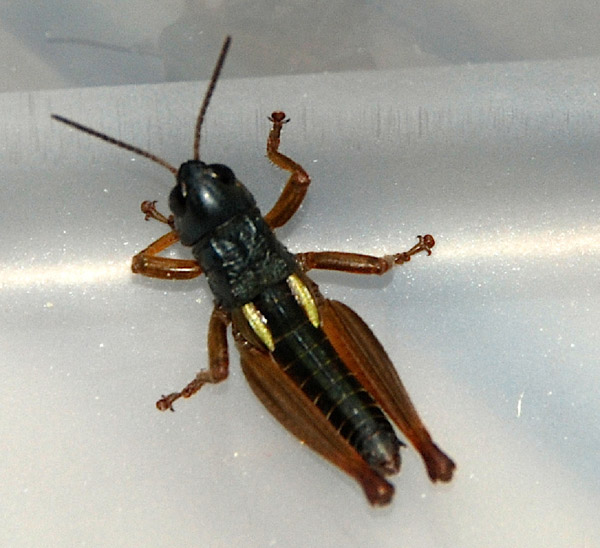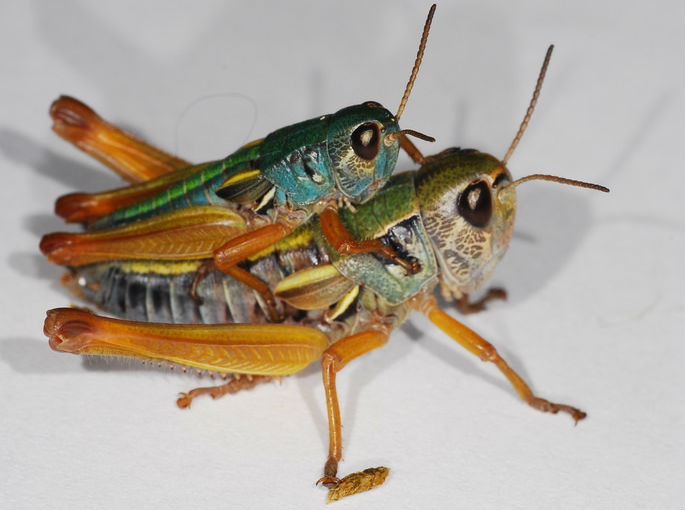Why so blue? Unravelling colour-change in the chameleon grasshopper

EVERY DAY, THIS bizarre species changes colour from black to bright turquoise, and then back to black again, and no one knows why.
Found in the Australian Alps, the chameleon grasshopper (Kosciuscola tristis) is one of our most peculiar insects. For one thing, they seem to be the only grasshoppers to display this temperature-driven, reversible colour change.
They’re also found exclusively in Australia’s extreme alpine region, where temperatures range from -3 to 25 degrees, and they’re the only species of grasshopper known to fight each other in violent skirmishes.
Are these peculiarities a coincidence, or are they all somehow connected?
Alpine anomaly
For more than half a century, scientists have been trying to explain the chameleon grasshopper’s colour change. While they’re still figuring out why it happens, we at least have a good idea of how it works.
At low temperatures, male chameleon grasshoppers are close to black in colour

(Image Credit: Dr Kate Umbers)
Below 10°C, they’re at their darkest colour, but as the mercury rises, the black starts to fade, and they take on a progressively brighter turquoise. By 25 degrees, the turquoise is at its most brilliant, and the change really is quite remarkable:

(Image Credit: Dr Kate Umbers)
The change is achieved not though pigment, but through tiny particles (or granules) inside the grasshoppers’ cells, which are arranged haphazardly at cold temperatures, but organised themselves into layers at warm temperatures. It’s this formation of the layers that is thought to cause the turquoise colour.
Dr Kate Umbers from Western Sydney University is one of the world’s leading experts on the species, and together with Dr Rachel Slatyer from ANU, she’s determined to solve the mystery.
“The turquoise is a structural colour, which means it’s not solely created by pigments,” Dr Umbers explains.
“At 25 degrees, small colourless granules form a nice little layer packed at the top of the cell. The granules interfere with incoming light, and reflect it in a way that appears to cause that beautiful turquoise colour. Larger granules (probably containing melanin) sit below the small granules, enhancing the purity of the turquoise colour by absorbing non-turquoise wavelengths of the incoming light.”
She adds that while temperature drives the change, it’s not like the grasshoppers are responding to the increased warmth by releasing hormones that trigger colour change. Instead, it’s a direct effect.
“You can isolate parts of their cuticle from the rest of their body, and it will still change colour,” she says. “It even occurs after they’ve died.”
While this is thought to be a unique phenomenon among grasshoppers, Dr Umbers says certain species of damselflies appear to have the same temperature-driven colour change.
But why do they do it?
After a decade of investigating, Dr Umbers is yet to find evidence that the colour change has something to do with helping the insects regulate temperature, but she’s not ready to discard this hypothesis just yet.
“In the 1950s, early experiments by Dr Max Day – who until recently was the oldest living scientist at the CSIRO – and entomologist Ken Key, a pioneer in Australian orthoptera, were looking for hormonal colour change, but they didn’t find any evidence of that,” says Dr Umbers.
“Then I came along, 60 years later, and wanted to know if circadian rhythm or light intensity, independent of temperature, was important. But found that only temperature affects it.”
Into the fray
Then there’s the question of whether sexual selection comes into play. While the female chameleon grasshoppers appear to achieve this colour-changing mechanism internally, it’s obscured from view on the outside, so only the males display the bright turquoise:

(Image Credit: Dr Kate Umbers)
According to Dr Umbers, the females don’t seem to care about male colouration, but the males might benefit from paying attention to each other’s colours, because they’re not afraid of some good, old-fashioned competition.
Male-on-male aggression is extremely unusual in grasshoppers – if not entirely unique – and one of Dr Umbers’ former PhD students, Dr Giselle Muschett, has been trying to find a connection between this fighting behaviour and the colour change.
She’s been documenting skirmishes between chameleon grasshopper males, and comparing them to several of the species’ its closest relatives that don’t exhibit the colour change.
“When the females lay their eggs, they have to stick their abdomen in the ground, so they become what we call a ‘defensible resource’ – they can’t move. This means the males can come and guard them and fight over them,” says Dr Umbers.
“They fight with their mandibles and display their mouths to each other. They look like little lions, it’s very cute. But it’s serious fighting. They wrestle and kick each other off the female, and they can certainly injure each other – they pull wings off and take chunks out of each other’s legs.”
Here they are in action:
Sightseeing
While the jury’s still out on what’s going on with the chameleon grasshopper, the good news is you can go and see them for yourself in the wild.
“Where they occur, they are super-abundant in summer, so they can be easy for people to see,” says Dr Umbers.
“The best places are the southern Kosciuszko hiking tracks around the ski fields in late summer and early autumn, between 1,600 and 1,900 metres of elevation. They’re really funny little guys. They’ve got a really interesting story, and it’s kind of killing me, as you can imagine! Those keen to visit the Alps in summer should check out our field guide app, Australian Alpine Insects.”
Perhaps even more important than the question of why the chameleon grasshopper changes colour is what the future holds for the species.
Very little is known about their population genetics, taxonomy, and distribution the Alps, so Dr Umbers is now focussing on these questions to inform conservation efforts about this enigmatic little species.
“We don’t yet understand why they’re the highest elevation species in their group; why they’ve got this weird colour change; and why they fight – but it seems like it could fit together,” she says.
“The bottom line is it’s unknown, and we’re still trying to solve it. Along the way, we’re discovering much more about how our threatened Alpine system works, and in particular how conservation management might be executed for the invertebrates of our high country.”




